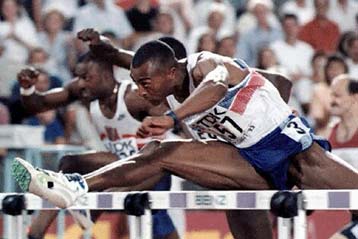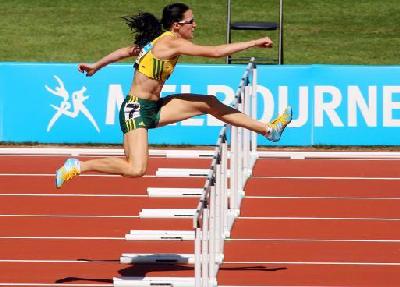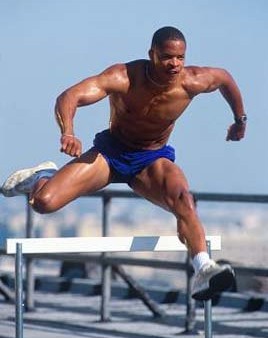
To lean or not to lean?
Many hurdlers and coaches ask themselfes this question. How much lean is actually required, when hurdling? Can one lean too much or too little? Do tall hurdles lean less then small one's? Should female hurdles lean at all? And what about the 400m hurdles?
What's going on?
 |
 |
| Leaning however reduces the athlete's control... | |
By leaning the body's center of gravity is lowered. This means we have to jump less high and the path our center of gravity travels over the hurdle is much more flat. Leaning however reduces the athlete's control, especially when re-erecting. The weight shifting, loss of body tension and introduced rotations are hard to compensate. And lean is also used to increase clearance height over the hurdle, leaving more room for bad technique. So leaning should be used with care.
There may not always be a need for some extra height over the hurdle. By simple laws of physics a minimum vertical component at takeoff is needed to cover the distance between takeoff and landing even without a hurdle. Unlike long-jumping the flight curve is symmetrical; the body's center of gravity is as high at touchdown as it was on takeoff. The elevation gain, covering up to 4 meters when hurdling, is considerable and must be taken into account. This 'natural' elevation can simply be obtained by the hurdler's flight time.
| 110m (s) | Speed (m/s) | Time (s) | Elevation (m) |
| 13,0 | 8,46 | 0,35 | 0,16 |
| 13,5 | 8,15 | 0,37 | 0,17 |
| 14,0 | 7,86 | 0,38 | 0,18 |
| 14,5 | 7,59 | 0,40 | 0,20 |
| 15,0 | 7,33 | 0,41 | 0,21 |
Calculated Elevation for different speeds and fixed flight distance of 3 meters.
In some cases this elevation is more then enough to clear the hurdle, of course depending on the hurdler's height, skill and the height of the hurdle. If this elevation is enough to clear the hurdle no lean should be used. If the elevation is not enough lean could be used to smooth the passage. From the sample table above can now easily be seen that elite hurdles are much more likely to lean than slower ones.
Other parameters involved
 |
| On 400m hurdles lean is seldom necessary... |
Using the simple explanation above many parameters to the lean-questions can be derived. The first one we've already discovered, fast hurdles lean more then slow ones. Tall hurdlers lean less then short ones for one obvious reason: Tall hurdlers need less elevation for clearance than short ones. But there is a second parameter that slightly contradicts the first one. It applies to 100/110 hurdles only. Tall hurdlers tend to have a shorter hurdle passage leaving more room for running between the hurdles. A shorter the passage leads to less elevation thus to more lean.
Female hurdlers lean less for the one reason only; their hurdles are, even taken average body length into account, much lower than the men's. Women do not need much elevation to clear a hurdle. But there are several reasons to lean more. Women's passage is much shorter than male's, so the elevation is less; the hurdles are closer together and women space hurdle clearance much more evenly with running than men do. A Woman's center of gravity is lower than a man's, so woman's lean is not an effective as man's is. Speed is not an issue here; women hurdle only slightly slower as men do.
The rules that apply to woman's hurdling do not apply to 400m hurdles. The hurdles are also lower but the passages are longer and slower, so much more elevation and lean is seldom necessary. (I know men are almost as fast over 400mH as over 110mH on average, but by looking at clearance speed 110m hurdlers are the fastest).
So what about practice?
 |
| Trail leg action is poor and far to low... |
In the previous paragraph we found some differences between groups but these are general tendencies towards more or less lean. On the track this knowledge is fundamental but not very practical. Let us look in too easy to spot lean faults.
Too much lean comes in two general flavors. The first is found among beginners and slow hurdlers: The hurdling clearance is very high; trail leg action is poor and far to low. The body lean should be discouraged until the trail leg is high enough and the clearance low. Lean can be easily reintroduced at a later stage, if necessary. The second flavor is found among technically gifted hurdles of all levels: the clearance is low and smooth but the athlete fails to run away from the hurdle. Hips, knees and ankle bend at touchdown, the first step away from the hurdle is slow and sticky, and the athlete fails to extend his hips. The real solution to this problem probably lies in strength and a more effective snap down of the lead leg. But until these conditions are meat the lean should be reduced.
To little lean comes only in one flavor. The hurdle clearance is smooth and low but the passage is far to long; the athlete fails to snap down his lead leg. And if he tries to snap his lead leg down he flips front ways. First the flight curve has to be adjusted; taking-off further away and landing closer to the hurdle. After that lean can be slowly encouraged with developing of a faster lead leg.
Updated 12-11-2017